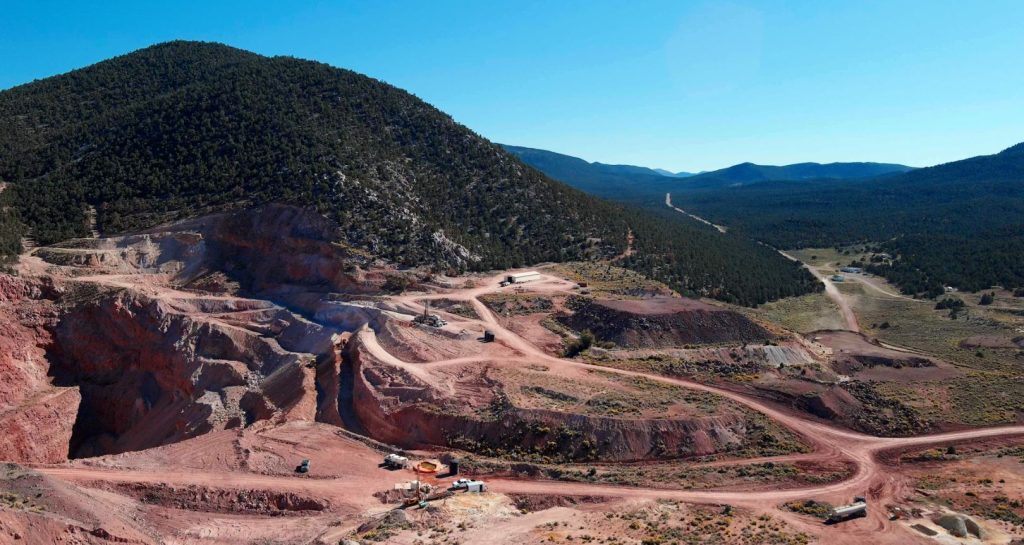Nevada King Gold drills 4.01 g/t gold over 21.3 metres at Atlanta mine, Nevada

Nevada King Gold Corp. [TSXV-NKG; OTCQX-NKGFF] reported assay results from 13 vertical reverse circulation (RC) holes recently completed within the north extension target (NET) at its Atlanta gold mine project, located in the prolific Battle Mountain trend, 264 km northeast of Las Vegas, Nevada.
Drill hole AT23NS-109 returned 13.7 metres of 3.69 g/t gold and 1.3 g/t silver. AT23NS-110 returned 25.9 metres of 1.21 g/t gold ans 3.3 g/t silver. AT23NS-112 returned 21.3 metres of 4.01 g/t gold and 6.7 g/t silver. AT23NS-127 returned 28.9 metres of 0.96 g/t gold and 1.5 g/t silver. AT23NS-15A returned 19.8 metres of 1.31 g/t gold and 12.1 g/t silver.
NET highlights: Today’s release outlines an area of shallowly hosted oxide gold mineralization spanning 250m long x 250m wide located approximately 600 metres north of the historic Atlanta Pit, along the northerly-trending Atlanta Mine Fault Zone (AMFZ). This mineralization occurs within the overall NET target area), which was originally identified through limited historical drilling, but was not pursued through more detailed drilling due to low grades and lean thicknesses.
Nevada King’s intercept of 8.26 g/t Au over 9.1m within 4.64 g/t Au over 18.3m in AT21-003 (November 22, 2021) was the first high-grade intercept at this target and transformed the company’s interpretation of the NET’s potential. Subsequent intercepts including 1.67 g/t Au over 24.4m in AT22NS-13 (November 23, 2022) and 1.83 g/t Au over 21.3m in AT22NS-15 (December 20, 2022) further expanded the interpreted envelope of higher-grade “core” mineralization localized along the AMFZ.
Mineralization occurs along a gently west-dipping horizon developed at the contact between basal Ordovician age dolomite and overlying Tertiary age volcanics. This contact is vertically displaced 60m to 80m across the northerly-trending AMFZ with the west side down.
The highest grade intervals are found proximal to the AMFZ along a 50 metre-wide corridor centred on the fault zone, as demonstrated by 4.01 g/t gold over 21.3 metres in AT23NS-112. Gold grades tend to gradually decrease westward and eastward from the AMFZ, although high-grade does occur outside of this corridor at the intersection of secondary faults or feeders, including highlight hole AT23NS-109 grading 3.69 g/t gold over 13.7 metres , 100 metres west of the AMFZ.
Mineralization within the NET shows strong lateral continuity and remains open to the south, west, and east, where it gradually shallows east of AT23NS-127 and trends into the currently untested East Ridge Target. The Company will focus additional drilling near to and east of the AMFZ with the goal of expanding the resource to include this area, where grades and thicknesses may be shallow enough to support stripping in a potential mining scenario. NET mineralization is not included in the existing resource.
Cal Herron, exploration manager, stated: “Sniffs of mineralization within the NET were found by past operators Kinross and Meadow Bay, but their drill patterns did not hit the higher-grade AMFZ, and consequently, the area was overlooked. By applying the company’s new geological model, Nevada King’s drilling has consistently hit higher-grade mineralization by focusing on identifying and targeting the high-angle feeder faults responsible for channeling high-grade gold along the AMFZ.
Similar to drilling conducted by the company further south in and around the Atlanta Pit, applying the new geological model has proven key to unlocking the potential of the NET. The Company will continue to expand the gold zone eastward, westward, and southward in the coming months, paying particular attention to suspected high-angle structures adjacent to the AMFZ that might result in thicker and higher grade mineralization within the low grade horizon. It is important to note all mineralization within the NET is oxidized.”
Nevada King is the third largest mineral claim holder in the State of Nevada, behind Nevada Gold Mines (Barrick/Newmont) and Kinross Gold. Starting in 2016 the company has staked large project areas hosting significant historical exploration work along the Battle Mountain trend located close to current or former producing gold mines.
District-scale projects in Nevada King’s portfolio include the 100%-owned Atlanta Mine, located 100km southeast of Ely, the Lewis and Horse Mountain-Mill Creek projects, both located between Nevada Gold Mines’ large Phoenix and Pipeline mines, and the Iron Point project, located 35km east of Winnemucca, Nevada.
